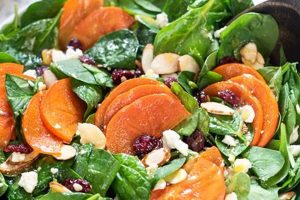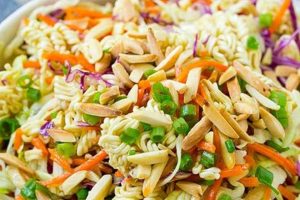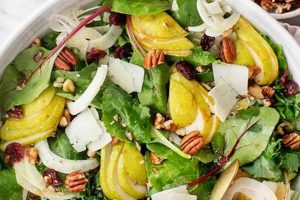A structured set of instructions for creating a layered salad provides a framework for combining diverse ingredients in a visually appealing and flavorful dish. This typically involves arranging components like vegetables, proteins, cheeses, and dressings in distinct horizontal layers within a deep, clear container. A classic example utilizes crisp lettuce, chopped tomatoes, crumbled bacon, hard-boiled eggs, shredded cheddar cheese, and a creamy dressing.
Layered salads offer several advantages. Their construction allows for individual components to retain their texture and flavor, preventing the sogginess that can occur in tossed salads. The visual presentation is often striking, making them a popular choice for potlucks, picnics, and festive gatherings. Furthermore, the make-ahead nature of many layered salads simplifies entertaining and meal preparation. Historically, these salads gained popularity as a convenient and attractive way to showcase fresh, seasonal produce.
This discussion will further explore various aspects of creating these salads, encompassing ingredient selection, layering techniques, dressing choices, and tips for successful presentation and storage.
Tips for Creating Layered Salads
Successful layered salads require careful planning and execution. The following tips offer guidance for achieving optimal results.
Tip 1: Select a suitable container. A clear, deep container, such as a trifle bowl or glass salad bowl, best showcases the layered presentation. Consider the serving size and occasion when choosing a container.
Tip 2: Prioritize crisp ingredients. Lettuce, vegetables, and other ingredients prone to wilting should be crisp and dry to maintain their texture and prevent sogginess.
Tip 3: Layer strategically. Denser ingredients, such as chopped vegetables or grains, form a stable base. More delicate items, like leafy greens, should be placed closer to the top. Consider color and texture variations for visual appeal.
Tip 4: Choose dressings wisely. Thicker dressings are less likely to seep through the layers and create a soggy salad. Consider the flavor profile of the salad when selecting a dressing. Alternatively, offer dressings on the side.
Tip 5: Prepare ingredients in advance. Chopping vegetables, cooking proteins, and grating cheese ahead of time streamlines the assembly process. Store components separately until ready to assemble the salad.
Tip 6: Assemble close to serving time. While some layered salads can be assembled a few hours in advance, it’s generally best to assemble them as close to serving time as possible to maintain ingredient freshness and prevent sogginess.
Tip 7: Seal airtight for storage. If assembling ahead of time, cover the container tightly with an airtight lid or plastic wrap to prevent the salad from drying out or absorbing odors from the refrigerator.
By following these tips, one can create a layered salad that is both visually appealing and delicious. Attention to detail and thoughtful ingredient selection ensure a successful outcome.
This guidance facilitates the creation of layered salads suitable for various occasions, from casual gatherings to more formal events.
1. Clear Glass Container
The clear glass container serves as a fundamental element in layered salad preparation. Its transparency allows for the visual appreciation of the carefully arranged ingredients, a key feature distinguishing layered salads from other salad types. This visual element enhances the dining experience, transforming a simple dish into an aesthetically pleasing presentation. The container’s depth accommodates multiple layers, crucial for showcasing the variety of textures and colors within the salad. Choosing the right container contributes significantly to the overall impact of the dish. For instance, a classic trifle bowl, with its sloping sides, provides an elegant presentation, while a straight-sided glass bowl offers a more modern aesthetic.
The practical implications of using a clear glass container extend beyond mere aesthetics. The ability to see the layers allows for precise portioning and ensures an even distribution of ingredients among servings. This is particularly beneficial when serving diverse groups with varying dietary preferences or restrictions. Furthermore, a clear container allows for quick assessment of remaining portions, aiding in meal planning and reducing food waste. Consider a layered salad served at a buffet or potluck: the transparent container allows guests to easily discern the ingredients, making informed choices and minimizing potential allergic reactions.
In conclusion, the clear glass container plays a vital role in layered salad construction, impacting both the visual appeal and practical functionality. The choice of container should be a considered decision, taking into account both aesthetic and practical considerations. Understanding this connection allows for a more informed approach to layered salad creation, resulting in a dish that is both visually stunning and functionally effective.
2. Crisp, Dry Ingredients
Ingredient texture and moisture content significantly influence the structural integrity and overall palatability of layered salads. Crisp, dry ingredients are essential for preventing sogginess and maintaining distinct layers, contributing to both the visual appeal and enjoyable consumption of the final product. Understanding the role of crisp, dry components is crucial for constructing a successful layered salad.
- Preventing Sogginess
Moisture migration between layers is a primary concern in layered salads. Crisp, dry ingredients minimize this issue, preventing the salad from becoming watery and unappetizing. This is particularly crucial for ingredients prone to releasing moisture, such as tomatoes and cucumbers. Proper drying techniques, such as patting ingredients with paper towels, enhance this effect. The absence of excess moisture preserves the texture of individual components, contributing to a more satisfying sensory experience. Consider the difference between a crisp lettuce leaf and a wilted one; the former contributes positively to the overall salad, while the latter detracts from it.
- Maintaining Structure
The structural integrity of a layered salad depends heavily on the firmness of its components. Crisp ingredients provide support, preventing the layers from collapsing and maintaining a visually appealing presentation. This is especially important for base layers, which bear the weight of the ingredients above. Imagine using overly ripe tomatoes as a base; their softness would compromise the entire structure. The use of crisp ingredients, such as chopped bell peppers or shredded carrots, ensures the salad remains visually appealing and structurally sound.
- Enhancing Flavor and Texture
Crispness contributes positively to the overall sensory experience of the salad. The contrast between textures, for instance, between crisp lettuce and creamy dressing, adds complexity and interest. The absence of excess moisture allows flavors to remain distinct and pronounced, preventing dilution and enhancing the overall taste profile. Consider the difference between a crisp cucumber slice and a soggy one; the former offers a refreshing crunch and clean flavor, while the latter is bland and texturally unpleasant.
- Extending Shelf Life
While layered salads are typically served fresh, using crisp, dry ingredients can extend their shelf life to a certain extent. Reduced moisture content minimizes the potential for bacterial growth and spoilage. This allows for make-ahead preparation, a valuable benefit for busy individuals or large gatherings. Proper storage, in airtight containers, further enhances this benefit, ensuring the salad remains fresh and enjoyable for a longer period. This contrasts with a salad made with wet ingredients, which would deteriorate more quickly.
The emphasis on crisp, dry ingredients in layered salad construction contributes significantly to the overall success of the dish. By understanding the impact of moisture content and texture on structural integrity, flavor, and shelf life, one can create layered salads that are both visually appealing and enjoyable to consume. This attention to detail elevates the layered salad from a simple dish to a carefully constructed culinary creation.
3. Strategic Layering
Strategic layering constitutes a critical element within layered salad construction. It directly impacts the final product’s visual appeal, textural complexity, flavor balance, and overall structural integrity. This process involves thoughtful arrangement of ingredients based on factors such as density, moisture content, color, and flavor profiles. A well-executed layering strategy elevates the dish beyond a simple combination of ingredients, transforming it into a carefully composed culinary creation.
Consider the impact of ingredient density. Denser items, like grains, beans, or chopped vegetables, typically form the foundation of the salad, providing a stable base and preventing lighter ingredients from sinking. Conversely, delicate components, such as leafy greens or herbs, are placed towards the top, maintaining their structure and preventing them from being crushed. A classic seven-layer salad exemplifies this principle, often utilizing a base of chopped lettuce, followed by layers of peas, diced carrots, bacon bits, shredded cheese, and sliced hard-boiled eggs, culminating in a top layer of crumbled crackers or croutons.
Moisture content also dictates layering strategy. Ingredients prone to releasing moisture, like tomatoes or cucumbers, benefit from placement above less absorbent layers, mitigating the risk of sogginess throughout the salad. This consideration ensures that individual components retain their desired texture and prevent the overall salad from becoming watery. Similarly, dressings, especially those with higher liquid content, are strategically applied to prevent premature wilting or softening of delicate ingredients. They may be layered between denser components or served on the side, allowing individuals to control the amount added.
Color and flavor play essential roles in creating visual interest and a balanced flavor profile. Alternating layers of contrasting colors enhances the aesthetic appeal, making the salad visually engaging. Furthermore, alternating layers with distinct flavor profiles ensures each bite offers a complex and harmonious blend of tastes. This might involve layering spicy peppers with cooling cucumbers, tangy cheeses with sweet fruits, or savory meats with fresh herbs. The strategic interplay of these elements elevates the layered salad from a simple combination of ingredients to a carefully orchestrated culinary experience.
4. Flavorful Dressings
Flavorful dressings play a crucial role in layered salad construction, impacting the overall taste profile, texture, and perceived freshness. Dressing selection and application require careful consideration to complement the layered ingredients without compromising structural integrity. The interplay between dressing and salad components contributes significantly to the final culinary experience.
The choice of dressing should harmonize with the diverse flavors within the layered salad. A creamy dressing, for instance, might complement a salad featuring roasted vegetables, grilled chicken, and crumbled cheese. Conversely, a vinaigrette provides a lighter, brighter counterpoint to salads emphasizing fresh greens, fruits, and lighter cheeses. Incorrect pairing can lead to flavor clashes or mask the subtle nuances of individual ingredients. Consider a robust blue cheese dressing applied to a delicate fruit and nut salad; the strong cheese flavor might overpower the other ingredients.
The method of dressing application also influences the final outcome. In layered salads, dressings are often strategically placed between denser layers to prevent delicate components from becoming soggy. This targeted approach allows for flavor enhancement while maintaining textural contrast. Alternatively, dressings can be served on the side, allowing individuals to customize their portion and control the overall moisture content of their salad. This approach also extends the salad’s shelf-life, particularly beneficial for potlucks or make-ahead meals.
Beyond flavor enhancement, dressings contribute to the perceived freshness and visual appeal of layered salads. A glossy dressing can enhance the vibrancy of colors and create an appetizing sheen on ingredients. However, excessive dressing can lead to a visually unappealing, soggy appearance. The goal is to enhance, not overwhelm, the layered composition. Consider the difference between a vibrant salad with a light coating of vinaigrette and one saturated in a heavy dressing; the former appears fresh and inviting, while the latter appears heavy and unappetizing.
In conclusion, the role of flavorful dressings in layered salads extends beyond simply adding flavor. Careful consideration of dressing type and application technique contributes significantly to the overall taste, texture, and presentation of the dish. Understanding this interconnectedness allows for the creation of layered salads that are both visually appealing and palate-pleasing, transforming a simple combination of ingredients into a well-balanced and enjoyable culinary experience.
5. Advance Preparation
Advance preparation plays a crucial role in the successful execution of layered salads, particularly when catering to larger gatherings or seeking to optimize time management. Pre-emptive ingredient preparation streamlines the assembly process, ensuring efficient construction and optimal ingredient freshness. Furthermore, it mitigates the risk of last-minute errors, allowing for a more controlled and predictable outcome. This proactive approach contributes significantly to the overall quality and presentation of the layered salad.
- Ingredient Preprocessing
Chopping vegetables, cooking proteins, grating cheese, and preparing other components in advance significantly reduces assembly time. This allows for a more focused and efficient layering process, ensuring the salad remains fresh and crisp. Pre-chopped vegetables can be stored in airtight containers to maintain their quality. Cooked proteins, such as grilled chicken or shrimp, can be cooled and refrigerated. Pre-shredded cheese eliminates a time-consuming step during final assembly. Consider a scenario where all ingredients are prepped before guests arrive; the host can then quickly assemble the salad, ensuring a timely and elegant presentation.
- Dressing Preparation
Making dressings ahead of time allows flavors to meld and intensify. This also allows for adjustments to seasonings and consistency before final application, ensuring a well-balanced flavor profile. Storing dressings separately prevents premature wilting or sogginess of salad components. For example, a vinaigrette prepared the day before allows the flavors of vinegar, oil, and herbs to harmonize fully. This proactive approach eliminates the need for last-minute dressing preparation and ensures a perfectly balanced flavor profile.
- Layer Planning
Pre-determining the arrangement of layers, considering factors like color, texture, and moisture content, ensures a visually appealing and structurally sound salad. This pre-planning prevents last-minute decisions that might compromise the final presentation. Sketching a layer diagram can be particularly helpful for complex or multi-layered salads. This allows for visualization of the final product and ensures a harmonious balance of colors, textures, and flavors. Consider a salad intended for a formal occasion; careful layer planning ensures a visually stunning and professionally presented dish.
- Container Selection and Preparation
Choosing and preparing the serving container in advance is crucial. This includes cleaning and, if necessary, chilling the container to maintain the salad’s temperature and freshness. This ensures a seamless transition from assembly to presentation. Having the container ready also prevents last-minute scrambling and potential delays during serving. Consider a large trifle bowl for a festive gathering; ensuring it is clean and chilled beforehand facilitates a smooth and elegant presentation of the layered salad.
By implementing these advance preparation techniques, the layered salad assembly process becomes more efficient and predictable. This proactive approach minimizes errors, optimizes ingredient freshness, and ultimately enhances the overall quality and presentation of the dish, contributing to a more successful and enjoyable culinary experience. The time saved translates into a more relaxed and enjoyable hosting experience, allowing for greater focus on guest interaction and overall event management.
6. Careful Storage
Careful storage is integral to preserving the quality and intended presentation of a layered salad, particularly when assembly precedes consumption. Improper storage can compromise textural integrity, flavor profiles, and overall aesthetic appeal, negating the careful planning and preparation invested in the layering process. Understanding the effects of storage conditions on individual components and the layered structure as a whole is crucial for maintaining the desired outcome. A layered salad featuring crisp lettuce, for instance, will quickly wilt if stored uncovered, rendering the final presentation unappetizing despite prior meticulous layering.
Several factors influence the optimal storage of layered salads. Airtight containers are essential for preventing oxidation and moisture loss, preserving the freshness and crispness of ingredients. Refrigeration maintains a safe temperature, inhibiting bacterial growth and slowing enzymatic processes that lead to spoilage. However, excessive chilling can negatively impact certain ingredients, such as tomatoes, which can lose flavor and texture when exposed to cold temperatures for extended periods. Layered salads containing such sensitive ingredients might benefit from partial assembly, with the addition of these components just prior to serving. Consider a layered salad containing avocado; storing the avocado separately and adding it just before serving prevents browning and preserves its optimal texture.
The duration of storage also affects the overall quality. While some layered salads can be successfully stored for a day or two, prolonged storage often leads to undesirable changes in texture and flavor. Leafy greens can wilt, vegetables can become soggy, and dressings can seep into other layers, compromising the intended visual and textural contrasts. Therefore, assembling the salad as close to serving time as possible is generally recommended. When advance preparation is necessary, careful consideration of ingredient selection and storage techniques can mitigate potential quality degradation. This understanding of the relationship between storage and quality allows for informed decisions regarding ingredient selection, assembly timing, and storage methods, ultimately contributing to a more successful and enjoyable layered salad experience. Neglecting careful storage can undermine even the most meticulously constructed layered salad, highlighting its critical role within the recipe’s overall framework.
Frequently Asked Questions
This section addresses common inquiries regarding the creation and enjoyment of layered salads.
Question 1: How long can a layered salad be stored?
While refrigeration helps maintain freshness, layered salads are best consumed within 24 hours of assembly to maximize optimal texture and flavor. Extended storage can lead to ingredient degradation and sogginess.
Question 2: Can any type of dressing be used in a layered salad?
Thicker dressings are generally preferred to prevent seepage and maintain distinct layers. Thinner dressings can be used, but require careful application and consideration of ingredient compatibility.
Question 3: What are the best vegetables for layered salads?
Crisp vegetables such as bell peppers, carrots, cucumbers, and onions hold their shape well. Softer vegetables like tomatoes should be placed strategically to avoid excessive moisture release.
Question 4: Can layered salads be made ahead of time for parties?
Advance preparation is possible and often beneficial for large gatherings. However, certain ingredients, such as avocados or leafy greens, are best added just prior to serving to maintain optimal quality.
Question 5: What type of container is best for a layered salad?
Clear glass containers, such as trifle bowls or straight-sided salad bowls, showcase the layered presentation most effectively. The container size should be chosen based on the anticipated serving size.
Question 6: How can sogginess be prevented in a layered salad?
Using crisp, dry ingredients, layering strategically with denser items at the base, and using thicker dressings or serving them on the side all contribute to sogginess prevention.
Understanding these considerations allows for successful creation and enjoyment of layered salads, enhancing both presentation and palatability.
The following section will explore variations and adaptations for specific dietary needs and preferences.
Conclusion
Systematic construction of layered salads involves a nuanced understanding of ingredient selection, strategic layering techniques, and appropriate dressing choices. Considerations regarding container selection, advance preparation, and careful storage contribute significantly to the final product’s quality and presentation. A well-executed layered salad offers not merely a culinary creation, but a testament to thoughtful planning and skillful execution, showcasing both aesthetic appeal and balanced flavors. Each component plays a crucial role, from the foundational base layer to the finishing touches of dressing and garnish.
Exploration of layered salad construction reveals a dynamic interplay between culinary art and scientific principles. Ingredient characteristics, moisture content, density, and flavor profiles interact within a defined structure, culminating in a dish that satisfies both visual and gustatory senses. Continued exploration of ingredient combinations and layering techniques offers endless possibilities for culinary innovation within this established framework. The layered salad serves as a testament to the potential for creativity and precision within the culinary arts, inviting further exploration and refinement of techniques.






